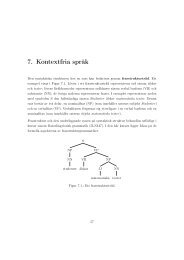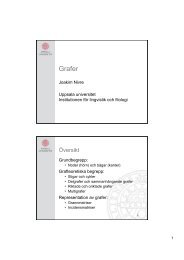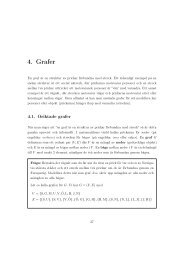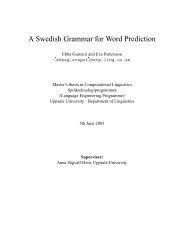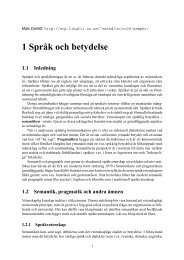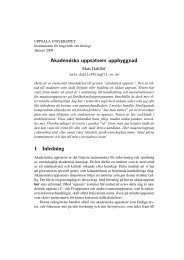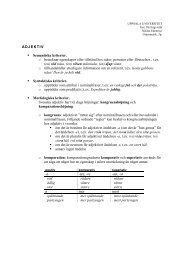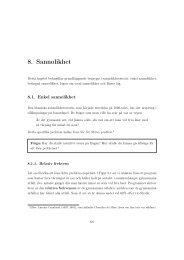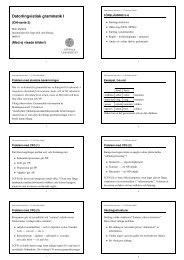Information Retrieval, Information Extraction, Question ... - Stp
Information Retrieval, Information Extraction, Question ... - Stp
Information Retrieval, Information Extraction, Question ... - Stp
Create successful ePaper yourself
Turn your PDF publications into a flip-book with our unique Google optimized e-Paper software.
<strong>Information</strong> <strong>Retrieval</strong> <strong>Information</strong> <strong>Extraction</strong> <strong>Question</strong> Answering<br />
<strong>Information</strong> <strong>Retrieval</strong>, <strong>Information</strong> <strong>Extraction</strong>,<br />
<strong>Question</strong> Answering<br />
Overview of Methods for <strong>Information</strong> Access<br />
Jörg Tiedemann<br />
jorg.tiedemann@lingfil.uu.se<br />
Department of Linguistics and Philology<br />
Uppsala University<br />
Jörg Tiedemann 1/57<br />
<strong>Information</strong> <strong>Retrieval</strong> <strong>Information</strong> <strong>Extraction</strong> <strong>Question</strong> Answering<br />
Terminology<br />
<strong>Information</strong> retrieval (IR) is finding material (usually<br />
documents) of an unstructured nature (usually text) that<br />
satisfies an information need from within large collections<br />
(usually stored on computers).<br />
<strong>Information</strong> <strong>Extraction</strong> (IE) is extracting structured information<br />
from unstructured machine-readable documents by means of<br />
natural language processing (NLP).<br />
<strong>Question</strong> Answering (QA) is answering a question posed in<br />
natural language and has to deal with a wide range of question<br />
types including: fact, list, definition, how, why, hypothetical,<br />
semantically constrained, and cross-lingual questions.<br />
Jörg Tiedemann 3/57<br />
<strong>Information</strong> <strong>Retrieval</strong> <strong>Information</strong> <strong>Extraction</strong> <strong>Question</strong> Answering<br />
<strong>Information</strong> <strong>Retrieval</strong> is part of our life!<br />
Jörg Tiedemann 2/57<br />
<strong>Information</strong> <strong>Retrieval</strong> <strong>Information</strong> <strong>Extraction</strong> <strong>Question</strong> Answering<br />
What are the challenges?<br />
◮ huge dynamic collections of diverse (multi-modal) material<br />
◮ users expect immediate answers<br />
◮ relevance ranking & personalization<br />
◮ access to everything everywhere (in various languages)<br />
Jörg Tiedemann 4/57
<strong>Information</strong> <strong>Retrieval</strong> <strong>Information</strong> <strong>Extraction</strong> <strong>Question</strong> Answering<br />
IR is more than general domain keyword search<br />
Jörg Tiedemann 5/57<br />
<strong>Information</strong> <strong>Retrieval</strong> <strong>Information</strong> <strong>Extraction</strong> <strong>Question</strong> Answering<br />
Literature<br />
Most information comes from this book:<br />
Freely available at:<br />
Christopher D. Manning, Prabhakar<br />
Raghavan and Hinrich Schütze:<br />
Introduction to <strong>Information</strong><br />
<strong>Retrieval</strong>, Cambridge University<br />
Press, 2008<br />
http://www-csli.stanford.edu/∼ hinrich/information-retrieval-book.html<br />
Jörg Tiedemann 7/57<br />
<strong>Information</strong> <strong>Retrieval</strong> <strong>Information</strong> <strong>Extraction</strong> <strong>Question</strong> Answering<br />
Outline for today<br />
<strong>Information</strong> <strong>Retrieval</strong><br />
Boolean <strong>Retrieval</strong><br />
Ranked <strong>Retrieval</strong><br />
Web <strong>Retrieval</strong><br />
<strong>Information</strong> <strong>Extraction</strong><br />
<strong>Question</strong> Answering<br />
Jörg Tiedemann 6/57<br />
<strong>Information</strong> <strong>Retrieval</strong> <strong>Information</strong> <strong>Extraction</strong> <strong>Question</strong> Answering<br />
<strong>Information</strong> <strong>Retrieval</strong><br />
<strong>Information</strong> retrieval (IR) is finding material (usually documents) of an<br />
unstructured nature (usually text) that satisfies an information need from<br />
within large collections (usually stored on computers).<br />
<strong>Question</strong>s to be answered<br />
◮ How do we match queries with documents?<br />
◮ How do we measure relevance?<br />
◮ What is a document?<br />
◮ How can we make this really fast?<br />
◮ How can we deal with HUGE diverse collections<br />
and MILLIONS of users?<br />
Jörg Tiedemann 8/57
<strong>Information</strong> <strong>Retrieval</strong> <strong>Information</strong> <strong>Extraction</strong> <strong>Question</strong> Answering<br />
<strong>Information</strong> <strong>Retrieval</strong><br />
Clues for relevance<br />
◮ document contents (text)<br />
◮ links between documents & their labels<br />
(hyperlinks, references, citations)<br />
◮ tags & captions<br />
◮ clicks & queries<br />
→ clue importance is shifting ...<br />
Jörg Tiedemann 9/57<br />
<strong>Information</strong> <strong>Retrieval</strong> <strong>Information</strong> <strong>Extraction</strong> <strong>Question</strong> Answering<br />
Bigger collections<br />
◮ Consider N = 10 6 documents (and ca. 10 9 tokens)<br />
◮ Assume there are M = 500,000 distinct terms<br />
→ M = 500,000 × 10 6 = half a trillion 0s and 1s.<br />
→ Term-document matrix is extremely sparse!<br />
(... and this is still a very small collection ...)<br />
Jörg Tiedemann 11/57<br />
<strong>Information</strong> <strong>Retrieval</strong> <strong>Information</strong> <strong>Extraction</strong> <strong>Question</strong> Answering<br />
Boolean retrieval<br />
Boolean model: document = set of terms<br />
(term Anthony Julius The Hamlet Othello Macbeth . . .<br />
document and Caesar Tempest<br />
matrix) Cleopatra<br />
ANTHONY 1 1 0 0 0 1<br />
BRUTUS 1 1 0 1 0 0<br />
CAESAR 1 1 0 1 1 1<br />
CALPURNIA 0 1 0 0 0 0<br />
CLEOPATRA 1 0 0 0 0 0<br />
MERCY 1 0 1 1 1 1<br />
WORSER 1 0 1 1 1 0<br />
. . .<br />
Boolean Query: BRUTUS AND CAESAR AND NOT CALPURNIA<br />
◮ Do a (bitwise) AND on three vectors<br />
◮ 110100 AND 110111 AND 101111 = 100100<br />
Problem solved?<br />
Jörg Tiedemann 10/57<br />
<strong>Information</strong> <strong>Retrieval</strong> <strong>Information</strong> <strong>Extraction</strong> <strong>Question</strong> Answering<br />
Inverted Index<br />
For each term t, store a sorted list of all doc’s that contain t.<br />
BRUTUS −→ 1 2 4 11 31 45 173 174<br />
CAESAR −→ 1 2 4 5 6 16 57 132 . . .<br />
CALPURNIA −→ 2 31 54 101<br />
.<br />
� �� � � �� �<br />
dictionary postings<br />
Jörg Tiedemann 12/57
<strong>Information</strong> <strong>Retrieval</strong> <strong>Information</strong> <strong>Extraction</strong> <strong>Question</strong> Answering<br />
Simple conjunctive query (two terms)<br />
Query = BRUTUS AND CALPURNIA<br />
BRUTUS −→ 1 → 2 → 4 → 11 → 31 → 45 → 173 → 174<br />
CALPURNIA −→ 2 → 31 → 54 → 101<br />
Intersection =⇒ 2 → 31<br />
◮ This is linear in the length of the postings lists!<br />
◮ Query optimization & skip pointers → make it even faster!<br />
◮ Exercise: BRUTUS AND CAESAR AND NOT CALPURNIA<br />
Jörg Tiedemann 13/57<br />
(Slides from Dan Russell, Google)<br />
<strong>Information</strong> <strong>Retrieval</strong> <strong>Information</strong> <strong>Extraction</strong> <strong>Question</strong> Answering<br />
Phrase queries with Positional Indexes<br />
◮ Example query: “to1 be2 or3 not4 to5 be6”<br />
TO, 993427:<br />
〈 1: 〈 7, 18, 33, 72, 86, 231〉;<br />
2: 〈1, 17, 74, 222, 255〉;<br />
4: 〈 8, 16, 190, 429, 433〉;<br />
5: 〈363, 367〉;<br />
7: 〈13, 23, 191〉; . . . 〉<br />
BE, 178239:<br />
〈 1: 〈 17, 25〉;<br />
4: 〈 17, 191, 291, 430, 434〉;<br />
5: 〈14, 19, 101〉; . . . 〉<br />
→ Also allows proximity search! (“employment /4 place”)<br />
Jörg Tiedemann 14/57
→ Boolean retrieval is not enough! Relevance ranking is important!<br />
<strong>Information</strong> <strong>Retrieval</strong> <strong>Information</strong> <strong>Extraction</strong> <strong>Question</strong> Answering<br />
tf-idf weighting<br />
◮ term frequency (tf) = measure of relevance<br />
◮ inverse document frequency (idf) = measure of<br />
informativeness of the term<br />
◮ increases with<br />
wt,d = (1 + log tft,d) · log N<br />
dft<br />
◮ number of occurrences within a document<br />
◮ rarity of the term in collection<br />
→ probably the best known weighting scheme in IR<br />
Jörg Tiedemann 19/57<br />
<strong>Information</strong> <strong>Retrieval</strong> <strong>Information</strong> <strong>Extraction</strong> <strong>Question</strong> Answering<br />
Bag of Words Model<br />
Anthony Julius The Hamlet Othello Macbeth . . .<br />
and Caesar Tempest<br />
Cleopatra<br />
ANTHONY 157 73 0 0 0 1<br />
BRUTUS 4 157 0 2 0 0<br />
CAESAR 232 227 0 2 1 0<br />
CALPURNIA 0 10 0 0 0 0<br />
CLEOPATRA 57 0 0 0 0 0<br />
MERCY 2 0 3 8 5 8<br />
WORSER 2 0 1 1 1 5<br />
. . .<br />
Each document is represented by a count vector ∈ N |V | (term frequency).<br />
Jörg Tiedemann 18/57<br />
<strong>Information</strong> <strong>Retrieval</strong> <strong>Information</strong> <strong>Extraction</strong> <strong>Question</strong> Answering<br />
Binary → count → weight matrix<br />
Anthony Julius The Hamlet Othello Macbeth . . .<br />
and Caesar Tempest<br />
Cleopatra<br />
ANTHONY 5.25 3.18 0.0 0.0 0.0 0.35<br />
BRUTUS 1.21 6.10 0.0 1.0 0.0 0.0<br />
CAESAR 8.59 2.54 0.0 1.51 0.25 0.0<br />
CALPURNIA 0.0 1.54 0.0 0.0 0.0 0.0<br />
CLEOPATRA 2.85 0.0 0.0 0.0 0.0 0.0<br />
MERCY 1.51 0.0 1.90 0.12 5.25 0.88<br />
WORSER 1.37 0.0 0.11 4.15 0.25 1.95<br />
. . .<br />
each document represented by a real-valued vector of tf-idf weights ∈ R |V | .<br />
How do we rank documents according to relevance?<br />
Jörg Tiedemann 20/57
<strong>Information</strong> <strong>Retrieval</strong> <strong>Information</strong> <strong>Extraction</strong> <strong>Question</strong> Answering<br />
Documents and queries as vectors<br />
→ Measure proximity between query and documents!<br />
→ Why not Euclidean distance?<br />
Jörg Tiedemann 21/57<br />
<strong>Information</strong> <strong>Retrieval</strong> <strong>Information</strong> <strong>Extraction</strong> <strong>Question</strong> Answering<br />
Cosine similarity between query and document<br />
Jörg Tiedemann 23/57<br />
<strong>Information</strong> <strong>Retrieval</strong> <strong>Information</strong> <strong>Extraction</strong> <strong>Question</strong> Answering<br />
Cosine similarity between query and document<br />
cos(�q, � d) = �q<br />
|�q| · � d<br />
| � d| =<br />
|V |<br />
�<br />
i=1<br />
qi<br />
� �|V |<br />
i=1 q2 i<br />
◮ qi is the tf-idf weight of term i in the query.<br />
◮ di is the tf-idf weight of term i in the document.<br />
◮ |�q| and | � d| are the lengths of �q and � d.<br />
·<br />
di<br />
�<br />
�|V |<br />
i=1 d 2<br />
i<br />
◮ �q/|�q| and � d/| � d| are length-1 vectors (= normalized).<br />
Jörg Tiedemann 22/57<br />
<strong>Information</strong> <strong>Retrieval</strong> <strong>Information</strong> <strong>Extraction</strong> <strong>Question</strong> Answering<br />
Time for <strong>Question</strong>s & Short Break<br />
To sum up ....<br />
◮ IR = searching relevant information in unstructured data<br />
collections<br />
◮ Boolean model: find exact matches<br />
◮ Inverted index: important data structure for IR<br />
◮ Ranking by relevance is important!<br />
◮ Vector-space model, tf-idf & cosine similarity<br />
Jörg Tiedemann 24/57
<strong>Information</strong> <strong>Retrieval</strong> <strong>Information</strong> <strong>Extraction</strong> <strong>Question</strong> Answering<br />
Part II<br />
◮ Tweaking performance for ranked retrieval<br />
◮ Web-based information retrieval<br />
◮ Link Analysis<br />
Jörg Tiedemann 25/57<br />
<strong>Information</strong> <strong>Retrieval</strong> <strong>Information</strong> <strong>Extraction</strong> <strong>Question</strong> Answering<br />
Components of various tf-idf weighting schemes<br />
Term frequency Document frequency Normalization<br />
n (natural) tft,d n (no) 1 n (none) 1<br />
l (logarithm) 1 + log(tft,d) t (idf) log N<br />
dft<br />
a (augmented) 0.5 + 0.5×tft,d maxt (tft,d )<br />
b (boolean)<br />
L (log ave)<br />
� 1 if tft,d > 0<br />
0 otherwise<br />
1+log(tf t,d )<br />
1+log(ave t∈d (tf t,d ))<br />
c (cosine)<br />
p (prob idf) max{0, log N−dft<br />
} u (pivoted<br />
dft<br />
unique)<br />
√ 1<br />
w 2<br />
1 +w 2 2 +...+w 2 M<br />
1/u<br />
b (byte size) 1/CharLength α ,<br />
α < 1<br />
◮ different weightings for queries & documents → qqq.ddd<br />
◮ example: ltn.lnc:<br />
◮ query: logarithmic tf, idf, no normalization<br />
◮ document: logarithmic tf, no df weighting, cosine normalization<br />
Jörg Tiedemann 27/57<br />
<strong>Information</strong> <strong>Retrieval</strong> <strong>Information</strong> <strong>Extraction</strong> <strong>Question</strong> Answering<br />
Predicted and true probability of relevance<br />
A problem with cosine normalization:<br />
(source: Lillian Lee)<br />
Jörg Tiedemann 26/57<br />
<strong>Information</strong> <strong>Retrieval</strong> <strong>Information</strong> <strong>Extraction</strong> <strong>Question</strong> Answering<br />
Efficient scoring<br />
Comparing each query with ALL documents is too expensive!<br />
◮ Use inverted index! (accumulate scores for doc’s in postings)<br />
◮ Store term frequencies in postings (space-efficient)!<br />
◮ Store document frequencies in dictionary!<br />
BRUTUS (dfBrutus) −→ 1,2 7,3 83,1 87,2 . . .<br />
CAESAR (dfCaesar ) −→ 1,1 5,1 13,1 17,1 . . .<br />
CALPURNIA (dfCalpurnia) −→ 7,1 8,2 40,1 97,3<br />
Don’t need full ranking! → efficient ranking with binary min heap!<br />
Jörg Tiedemann 28/57
<strong>Information</strong> <strong>Retrieval</strong> <strong>Information</strong> <strong>Extraction</strong> <strong>Question</strong> Answering<br />
Binary min heap for selecting top k<br />
binary min heap = binary tree in which each node’s value is<br />
less than the values of its children<br />
◮ always keep top k documents seen so far<br />
◮ takes O(J log k) operations to construct<br />
◮ read off k winners in O(k log k) steps<br />
Jörg Tiedemann 29/57<br />
<strong>Information</strong> <strong>Retrieval</strong> <strong>Information</strong> <strong>Extraction</strong> <strong>Question</strong> Answering<br />
Index elimination & Champion lists<br />
◮ only consider high-idf query terms<br />
◮ query: catcher in the rye<br />
◮ accumulate scores for catcher and rye only<br />
◮ only consider doc’s containing many query terms<br />
◮ for example, fixed proportion (3 out of 4)<br />
◮ Champion lists:<br />
◮ For each term in dictionary: precompute r documents of<br />
heighest weight (in the postings of the term)<br />
◮ query: only compute scores for documents in union of<br />
champion lists for all query terms<br />
◮ fixed r or depending on term value (e.g. idf-based)<br />
Jörg Tiedemann 31/57<br />
<strong>Information</strong> <strong>Retrieval</strong> <strong>Information</strong> <strong>Extraction</strong> <strong>Question</strong> Answering<br />
Inexact top k retrieval<br />
Cosine comparison is still expensive!<br />
→ Goal: find a set A of “contenders” with k < |A|
<strong>Information</strong> <strong>Retrieval</strong> <strong>Information</strong> <strong>Extraction</strong> <strong>Question</strong> Answering<br />
Static quality scores<br />
How does this help?<br />
◮ postings are ordered by g(d) – still consistent order!<br />
◮ traverse postings and compute scores as usual<br />
◮ early termination is possible<br />
◮ stop if minimal score cannot be improved<br />
◮ time threshold<br />
◮ threshold for goodness score<br />
◮ can be combined with champion lists<br />
Jörg Tiedemann 33/57<br />
<strong>Information</strong> <strong>Retrieval</strong> <strong>Information</strong> <strong>Extraction</strong> <strong>Question</strong> Answering<br />
Link Analysis<br />
◮ A query “IBM” might not match the contents of the IBM<br />
homepage!<br />
◮ there are many other pages linking to IBM’s homepage<br />
page A anchor text → page B<br />
→ hyperlink is a quality signal<br />
→ anchor text (or local context) desribes contents of page B<br />
Index anchor texts & link analyses<br />
Jörg Tiedemann 35/57<br />
<strong>Information</strong> <strong>Retrieval</strong> <strong>Information</strong> <strong>Extraction</strong> <strong>Question</strong> Answering<br />
Web Search Engines<br />
Web search engines must crawl their documents!<br />
◮ initialize with known seed pages (URLs)<br />
◮ fetch & parse pages from the URLs in the queue<br />
◮ extract URLs from those pages & add them to the queue<br />
Efficient crawling needs to address several things:<br />
◮ need to distribute to scale-up, prioritize<br />
◮ need (near-)duplicate detection, spam detection<br />
◮ web politeness, crawler strategies<br />
◮ need robustness (spider traps, large sites, dynamic pages)<br />
◮ need to re-crawl periodically (some sites more often)<br />
Jörg Tiedemann 34/57<br />
<strong>Information</strong> <strong>Retrieval</strong> <strong>Information</strong> <strong>Extraction</strong> <strong>Question</strong> Answering<br />
Link Analysis<br />
◮ just counting “in-links” → easily spammed<br />
◮ link from more important page → stronger quality signal<br />
◮ hyperlinks = weighted vote of page A for page B<br />
→ PageRank<br />
◮ model: likelihood that a random surfer arrives at page B<br />
◮ markov chain model: web = probabilistic directed<br />
connected graph<br />
◮ web-page = state, N x N probability transition matrix (links)<br />
◮ PageRank = long-term visit rate = steady-state probability<br />
Jörg Tiedemann 36/57
<strong>Information</strong> <strong>Retrieval</strong> <strong>Information</strong> <strong>Extraction</strong> <strong>Question</strong> Answering<br />
Link Analysis - Example Graph<br />
Link Matrix<br />
d0 d1 d2 d3 d4 d5 d6<br />
d0 0 0 1 0 0 0 0<br />
d1 0 1 1 0 0 0 0<br />
d2 1 0 1 1 0 0 0<br />
d3 0 0 0 1 1 0 0<br />
d4 0 0 0 0 0 0 1<br />
d5 0 0 0 0 0 1 1<br />
d6 0 0 0 1 1 0 1<br />
Jörg Tiedemann 37/57<br />
<strong>Information</strong> <strong>Retrieval</strong> <strong>Information</strong> <strong>Extraction</strong> <strong>Question</strong> Answering<br />
Link Analysis - PageRank<br />
d0 d1 d2 d3 d4 d5 d6<br />
d0 0.02 0.02 0.88 0.02 0.02 0.02 0.02<br />
d1 0.02 0.45 0.45 0.02 0.02 0.02 0.02<br />
d2 0.31 0.02 0.31 0.31 0.02 0.02 0.02<br />
d3 0.02 0.02 0.02 0.45 0.45 0.02 0.02<br />
d4 0.02 0.02 0.02 0.02 0.02 0.02 0.88<br />
d5 0.02 0.02 0.02 0.02 0.02 0.45 0.45<br />
d6 0.02 0.02 0.02 0.31 0.31 0.02 0.31<br />
◮ xt,i = chance of being in state i during the<br />
random walk (�xt = (xt,1, xt,2, .., xt,N))<br />
◮ steady-state probabilities<br />
�x∗ = �π = (π1, π2, ..., πN) = �πP<br />
◮ task: find this �π (= left eigenvector with<br />
largest eigenvalue)<br />
→ power method (iterative procedure)<br />
Jörg Tiedemann 39/57<br />
<strong>Information</strong> <strong>Retrieval</strong> <strong>Information</strong> <strong>Extraction</strong> <strong>Question</strong> Answering<br />
Link Analysis - Example Graph<br />
Probability matrix P<br />
d0 d1 d2 d3 d4 d5 d6<br />
d0 0.00 0.00 1.00 0.00 0.00 0.00 0.00<br />
d1 0.00 0.50 0.50 0.00 0.00 0.00 0.00<br />
d2 0.33 0.00 0.33 0.33 0.00 0.00 0.00<br />
d3 0.00 0.00 0.00 0.50 0.50 0.00 0.00<br />
d4 0.00 0.00 0.00 0.00 0.00 0.00 1.00<br />
d5 0.00 0.00 0.00 0.00 0.00 0.50 0.50<br />
d6 0.00 0.00 0.00 0.33 0.33 0.00 0.33<br />
avoid dead ends → add teleportation rate<br />
(e.g. 14% chance to jump to any random page)<br />
Jörg Tiedemann 38/57<br />
<strong>Information</strong> <strong>Retrieval</strong> <strong>Information</strong> <strong>Extraction</strong> <strong>Question</strong> Answering<br />
Link Analysis - Compute PageRanks<br />
Power Method to find �π = �πP<br />
1. start with random distribution<br />
�x0 = (x0,1, x0,2, .., x0,N)<br />
2. at step t compute �xt = �xt−1P:<br />
xt,k =<br />
N�<br />
i=1<br />
xt−1,iPi,k<br />
3. continue with 2. until convergence (�π = �xm = �x0P m )<br />
Jörg Tiedemann 40/57
<strong>Information</strong> <strong>Retrieval</strong> <strong>Information</strong> <strong>Extraction</strong> <strong>Question</strong> Answering<br />
Link Analysis<br />
◮ PageRank is behind Google’s early success (Larry Page)<br />
◮ PageRanks are query-independent (pre-computed)<br />
◮ re-rank retrieved documents by their PageRank<br />
(together with text match, anchor text match, ...)<br />
Drawback: query-independent scores for all pages<br />
→ Hypertext Induced Topic Search (HITS)<br />
◮ retrieve relevant pages<br />
◮ page rankings for hubs & authorities<br />
◮ problems: on-the-fly computation, topic drift, easy to spam<br />
Jörg Tiedemann 41/57<br />
<strong>Information</strong> <strong>Retrieval</strong> <strong>Information</strong> <strong>Extraction</strong> <strong>Question</strong> Answering<br />
Part III<br />
◮ Some words about building practical IR engines<br />
◮ <strong>Information</strong> <strong>Extraction</strong><br />
◮ <strong>Question</strong> Answering<br />
Jörg Tiedemann 43/57<br />
<strong>Information</strong> <strong>Retrieval</strong> <strong>Information</strong> <strong>Extraction</strong> <strong>Question</strong> Answering<br />
Time for <strong>Question</strong>s & Short Break<br />
To sum up part II ....<br />
◮ several weighting schemes for vector-space models<br />
◮ data structures for efficient retrieval<br />
◮ web search & link analysis<br />
◮ PageRank & HITS<br />
Jörg Tiedemann 42/57<br />
<strong>Information</strong> <strong>Retrieval</strong> <strong>Information</strong> <strong>Extraction</strong> <strong>Question</strong> Answering<br />
Other practical issues when building IR systems<br />
◮ Tiered indexes<br />
◮ cascaded query processing<br />
◮ index with most important terms & doc’s first<br />
◮ Zones<br />
◮ different indexes for various parts of a doc (title, body ...)<br />
◮ Query term proximity<br />
◮ more relevant: keywords in close proximity to each other<br />
◮ Query parsing<br />
◮ check syntax<br />
◮ create actual index queries<br />
◮ combine results<br />
→ All parts need careful tuning! (→ Evaluation is important!)<br />
Jörg Tiedemann 44/57
<strong>Information</strong> <strong>Retrieval</strong> <strong>Information</strong> <strong>Extraction</strong> <strong>Question</strong> Answering<br />
IR system architecture<br />
Jörg Tiedemann 45/57<br />
<strong>Information</strong> <strong>Retrieval</strong> <strong>Information</strong> <strong>Extraction</strong> <strong>Question</strong> Answering<br />
<strong>Information</strong><strong>Extraction</strong><br />
Sub-tasks:<br />
◮ named entity recognition<br />
◮ coreference resoultion<br />
◮ terminology extraction<br />
◮ relationship extraction<br />
Find patterns like<br />
◮ PERSON works for ORGANIZATION<br />
◮ PERSON lives in LOCATION<br />
Precision is usually more important than Recall!<br />
Jörg Tiedemann 47/57<br />
<strong>Information</strong> <strong>Retrieval</strong> <strong>Information</strong> <strong>Extraction</strong> <strong>Question</strong> Answering<br />
<strong>Information</strong><strong>Extraction</strong><br />
<strong>Information</strong> <strong>Extraction</strong> (IE) is extracting structured information from<br />
unstructured machine-readable documents by means of natural language<br />
processing (NLP).<br />
Motivation:<br />
◮ unstructured diverse data collections are full of information<br />
◮ extract & store world knowledge from those collections<br />
◮ structured collections (databases) for many puposes<br />
◮ searchable fact databases<br />
◮ question answering<br />
→ for example, turn Wikipedia into a well-structured fact-DB<br />
Jörg Tiedemann 46/57<br />
<strong>Information</strong> <strong>Retrieval</strong> <strong>Information</strong> <strong>Extraction</strong> <strong>Question</strong> Answering<br />
<strong>Information</strong><strong>Extraction</strong><br />
IE often requires heavy NLP and semantic inference<br />
◮ extract dates of people’s death<br />
◮ ...and when on September 18, 1970, Jimi<br />
Hendrix died of an overdose, her<br />
reaction...<br />
◮ extract capitals of countries in the world<br />
◮ The riders had a tour of Moscow this<br />
morning. Tomorrow morning they are leaving<br />
the Russian capital..<br />
Simple cases exist (e.g. infoboxes at Wikipedia)<br />
Jörg Tiedemann 48/57
<strong>Information</strong> <strong>Retrieval</strong> <strong>Information</strong> <strong>Extraction</strong> <strong>Question</strong> Answering<br />
<strong>Question</strong> Answering<br />
<strong>Question</strong> Answering (QA) is answering a question posed in natural<br />
language and has to deal with a wide range of question types including: fact,<br />
list, definition, how, why, hypothetical, semantically constrained, and<br />
cross-lingual questions.<br />
Motivation:<br />
◮ retrieve specific information<br />
◮ do it in a more natural (human) way<br />
◮ possibly integrate this in a dialogue system<br />
◮ follow-up questions (with coreferences)<br />
◮ interactive topic specific dialogues<br />
◮ multi-modal, speech recognition & synthesis<br />
→ Very ambitious!<br />
Jörg Tiedemann 49/57<br />
<strong>Information</strong> <strong>Retrieval</strong> <strong>Information</strong> <strong>Extraction</strong> <strong>Question</strong> Answering<br />
<strong>Question</strong> Answering Systems (Example: Joost)<br />
Jörg Tiedemann 51/57<br />
<strong>Information</strong> <strong>Retrieval</strong> <strong>Information</strong> <strong>Extraction</strong> <strong>Question</strong> Answering<br />
<strong>Question</strong> Answering: Why is this difficult?<br />
◮ When was the unification of Germany?<br />
◮ Already in 1961 he predicted the unification of Germany.<br />
◮ What is the capital of Ireland?<br />
◮ It is a common joke in Ireland to call Cork the “real capital<br />
of Ireland”<br />
◮ In the middle ages Kilkenny was the capital of Ireland<br />
◮ What is RSI?<br />
◮ Website with “Common misconceptions about RSI” ....<br />
RSI is the same as a mouse arm.<br />
Jörg Tiedemann 50/57<br />
<strong>Information</strong> <strong>Retrieval</strong> <strong>Information</strong> <strong>Extraction</strong> <strong>Question</strong> Answering<br />
<strong>Question</strong> Answering: How good is it?<br />
◮ acceptable for simple factoid questions<br />
◮ off-line IE is very effective<br />
◮ still quite bad for more complex cases<br />
◮ too slow due to heavy NLP<br />
→ needs still a lot of development<br />
→ Google starts integrating some QA functionalities<br />
Jörg Tiedemann 52/57
<strong>Information</strong> <strong>Retrieval</strong> <strong>Information</strong> <strong>Extraction</strong> <strong>Question</strong> Answering<br />
<strong>Question</strong> Answering with Google<br />
Jörg Tiedemann 53/57<br />
<strong>Information</strong> <strong>Retrieval</strong> <strong>Information</strong> <strong>Extraction</strong> <strong>Question</strong> Answering<br />
<strong>Question</strong> Answering vs. IR<br />
<strong>Information</strong> <strong>Retrieval</strong><br />
◮ input: keywords (+ boolean<br />
operators, ...)<br />
◮ output: links to relevant<br />
documents (maybe snippets)<br />
◮ techniques: vector-space<br />
model, bag-of-words, tf-idf,<br />
PageRank<br />
<strong>Question</strong> Answering<br />
◮ input: natural language<br />
question<br />
◮ output: concrete answer<br />
(facts or text)<br />
→ IR is just a component of question answering!<br />
→ QA → more NLP → more fun (?!)<br />
◮ techniques: shallow/deep<br />
NLP, passage retrieval (IR),<br />
information extraction<br />
Jörg Tiedemann 55/57<br />
<strong>Information</strong> <strong>Retrieval</strong> <strong>Information</strong> <strong>Extraction</strong> <strong>Question</strong> Answering<br />
<strong>Question</strong> Answering with Google<br />
Jörg Tiedemann 54/57<br />
<strong>Information</strong> <strong>Retrieval</strong> <strong>Information</strong> <strong>Extraction</strong> <strong>Question</strong> Answering<br />
Summary<br />
<strong>Information</strong> retrieval (IR) is finding material (usually documents) of an<br />
unstructured nature (usually text) that satisfies an information need from<br />
within large collections (usually stored on computers).<br />
→ effective shallow techniques — in daily use<br />
<strong>Information</strong> <strong>Extraction</strong> (IE) is extracting structured information from<br />
unstructured machine-readable documents by means of natural language<br />
processing (NLP).<br />
→ (mostly shallow) NLP — used for data mining<br />
<strong>Question</strong> Answering (QA) is answering a question posed in natural<br />
language and has to deal with a wide range of question types including: fact,<br />
list, definition, how, why, hypothetical, semantically constrained, and<br />
cross-lingual questions.<br />
→ heavy NLP — still more like a research area<br />
Jörg Tiedemann 56/57
<strong>Information</strong> <strong>Retrieval</strong> <strong>Information</strong> <strong>Extraction</strong> <strong>Question</strong> Answering<br />
What we didn’t talk about ...<br />
◮ measures for evaluation (very important!)<br />
◮ index construction<br />
◮ pre-processing (conversion, tokenzation, lemmatization ...)<br />
◮ distributed indexing, dynamic indexing<br />
◮ index compression<br />
◮ relevance feedback, query expansion, tolerant retrieval<br />
◮ XML & other semi-structured document retrieval<br />
◮ probabilistic IR & LM-based IR<br />
◮ text classification & topic clustering<br />
◮ dimensionality reduction & semantic clusters<br />
◮ personalization, cross-lingual IR, ...<br />
Jörg Tiedemann 57/57




